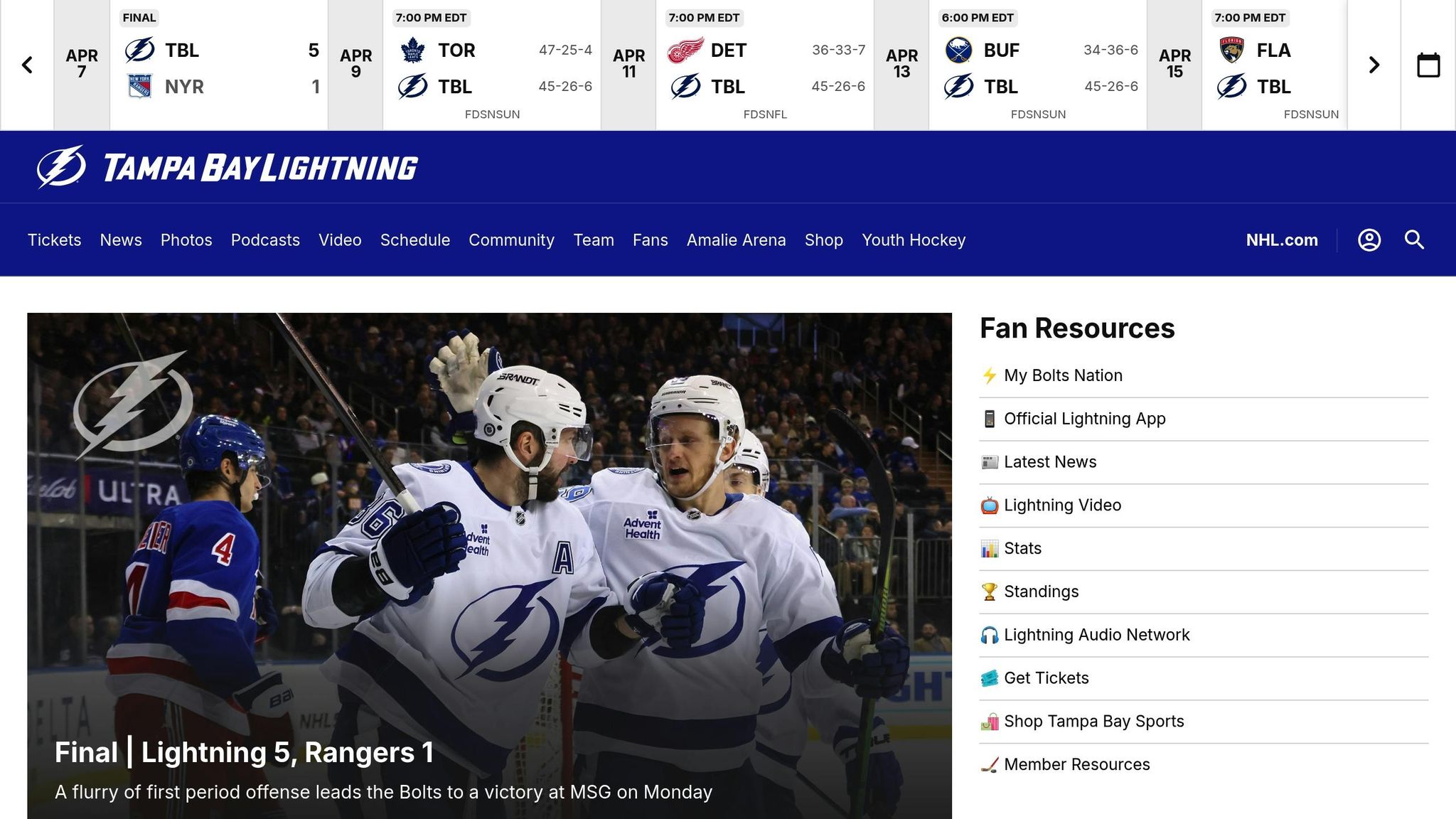Street hockey was all about fun, creativity, and making up rules that worked for everyone. Here are the 5 most memorable rules we invented as kids:
- Car Pause Rule: Yell "Car!" to stop the game, clear the street, and resume once the car passes.
- Honor System Calls: No referees - players made their own calls and settled disputes quickly.
- Makeshift Goalie Equipment: Couch cushions, winter gloves, and even pillows became goalie gear.
- High Stick Exceptions: Special rules like "Slapshot Freedom Zone" and "Telephone Wire Rule" made high sticking less strict.
- Sudden Death Overtime: First goal wins, with added twists like no goalie swaps and a "shootout line."
These rules turned simple games into unforgettable memories, teaching teamwork, honesty, and problem-solving. Keep reading for the full details behind each rule!
Local kids inspired to play street hockey by the Lightning

1. The Car Pause Rule
In street hockey, the "Car!" call was the ultimate signal for an unplanned timeout.
The concept was straightforward: if anyone saw a car approaching, they'd yell "Car!" loud enough for everyone to hear. Play stopped instantly, and players cleared the street. Once the car passed, the game resumed exactly where it had paused.
During heated matches, a routine emerged: goalies would grab the nets, forwards would gather loose balls or pucks, and everyone quickly moved out of the way. Some variations of the rule included giving the ball back to the player who had it when "Car!" was called and requiring a group "Game on!" before restarting.
This rule wasn’t just about safety; it also encouraged quick thinking, teamwork, and respect for the shared space. It was a perfect example of how street hockey thrived on adaptability and improvisation.
2. Honor System Calls
Without referees, we relied on each other to make calls for fouls, goals, and out-of-bounds plays. Players would announce calls like "High stick!" or "That was in!" and it was understood that everyone would respect them - even if things got heated at times. This approach naturally laid the groundwork for other unwritten rules.
Interestingly, an unspoken hierarchy often emerged. The kid who owned the ball or the street hockey gear tended to have a bit more say when conflicts arose. This meant players had to work out disagreements quickly to keep the game moving. A few arguments each week were just part of the deal.
This honor system taught us to think on our feet, be honest, and handle conflicts. While it might have looked messy to outsiders, it built a sense of fairness and teamwork that kept us coming back for more.
sbb-itb-d0a8c9d
3. Makeshift Goalie Equipment
Back in the day, goalies had to get creative with their gear because proper equipment wasn’t easy to find.
Old couch cushions often doubled as leg pads, while newspapers or magazines were stuffed in for extra protection. Baseball mitts or winter gloves became makeshift catching gloves, and blockers could be anything from a piece of cardboard to the lid of an old plastic trash can. These DIY solutions weren’t just practical - they set the stage for even more resourceful approaches.
For chest protection, players would wear thick winter coats. One particularly clever rule was the “pillow rule.” If a goalie brought a pillow from home to use as padding, they had to share it with others when switching positions. This way, everyone got a chance to test out different setups.
This mix of resourcefulness and ingenuity was a hallmark of street hockey. Everyday household items turned into essential gear, adding a layer of creativity to every game. It wasn’t just about saving money - it made each match feel special and one-of-a-kind.
4. High Stick Exceptions
Official hockey rules strictly prohibit high sticking - using a stick above an opponent's shoulders is deemed dangerous. But in our neighborhood games, we came up with our own twists to keep things fun and interesting. Here are three exceptions we created that became staples of our matches:
- Slapshot Freedom Zone: If a player was shooting from beyond a specific marker, they could take a full wind-up without worrying about stick height. The only catch? They had to yell "SHOT!" first to alert everyone.
- Telephone Wire Rule: Sometimes, the ball would get stuck in the telephone wires overhead. In these cases, players could use their sticks above shoulder height to knock it down - no penalties here.
- Height Handicap: Since our games included players of all ages and sizes, we adjusted the stick height rule based on the player's height. Shorter players got a little more flexibility when facing taller opponents.
These exceptions kept things lively while still emphasizing safety. Of course, reckless swings or sloppy play earned a quick trip to the "penalty curb."
5. Sudden Death Overtime
In our neighborhood street hockey games, sudden death overtime was the ultimate tie-breaker: the first goal decided everything. We took inspiration from the golden goal concept but added our own twists to make it even more thrilling:
- Same Goalies Stay Put: No swapping goalies during overtime, which led to some incredible diving saves from players in their makeshift gear.
- Shootout Line Rule: Every shot had to come from beyond a designated spot - our version of the blue line, marked by a trusty sewer grate - to keep things fair and avoid easy tap-ins.
- No Time Limit: We kept playing until someone finally scored.
The tension during sudden death was unmatched. Games often dragged into the evening, with kids rotating in and out under the glow of streetlights.
The sound of a tennis ball clanging off the garbage can we used as a goal, followed by cheers or groans, became the anthem of our summer nights. Those moments captured the heart of our street hockey battles, making them unforgettable.
Conclusion
Street hockey rules turned a simple game into a celebration of community, resourcefulness, and unforgettable moments. They worked around limited equipment, creating a shared experience that left lasting impressions.
As NHL Alumnus Andrew Ference put it, reimagining hockey helps us reconnect with the sport's pure joy.
Players found clever ways to adapt the game to their environment - like using sewer grates as boundaries or inventing new solutions on the fly. This creativity isn't unique to street hockey; it reflects the spirit of many street sports, where players craft their own rules to fit their surroundings.
These improvised rules had a big impact by:
- Encouraging everyone to participate, no matter their skill level
- Sparking creativity and problem-solving
- Teaching lessons about compromise and fairness
- Giving players a sense of ownership over the game
Got your own childhood game rules that stand out? Share them below and let’s celebrate the imagination that made those games so special.

